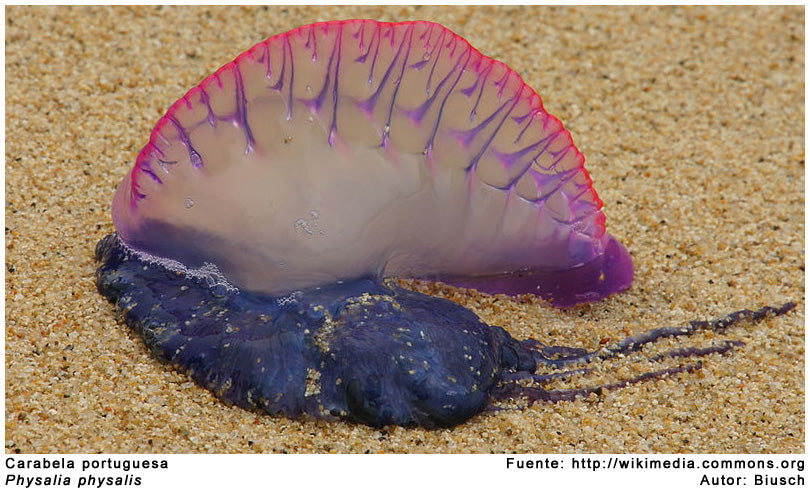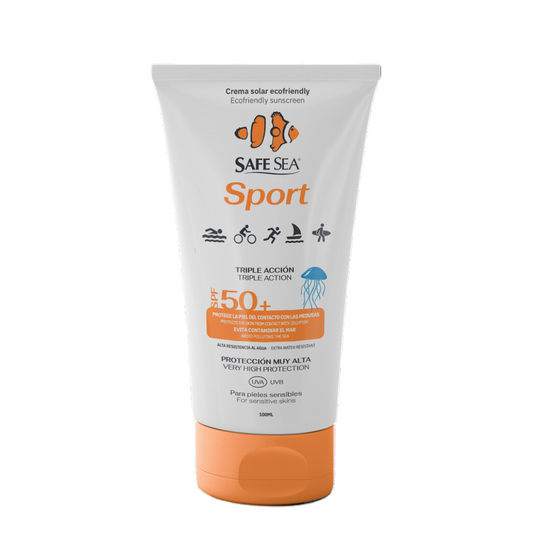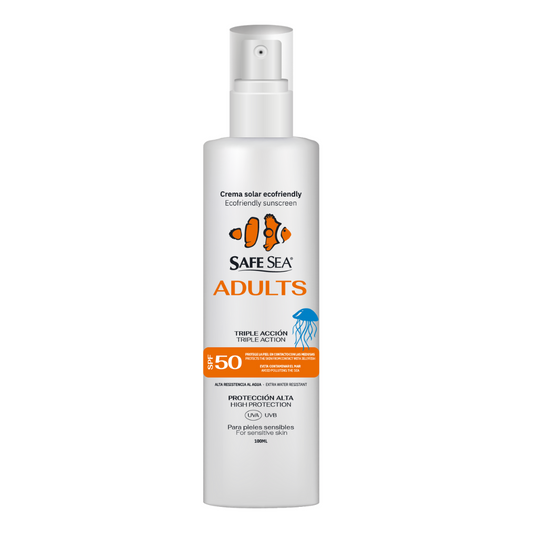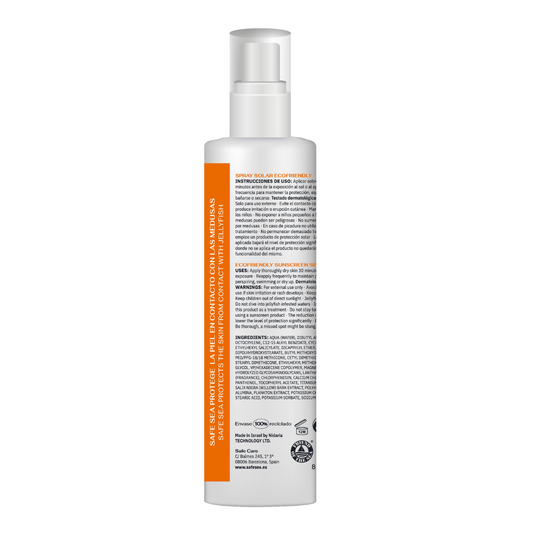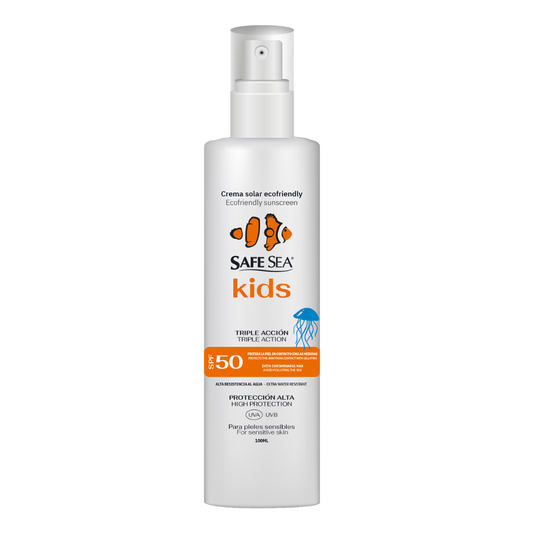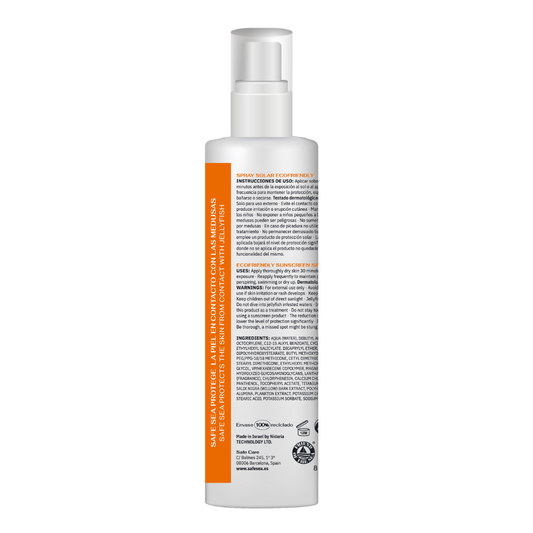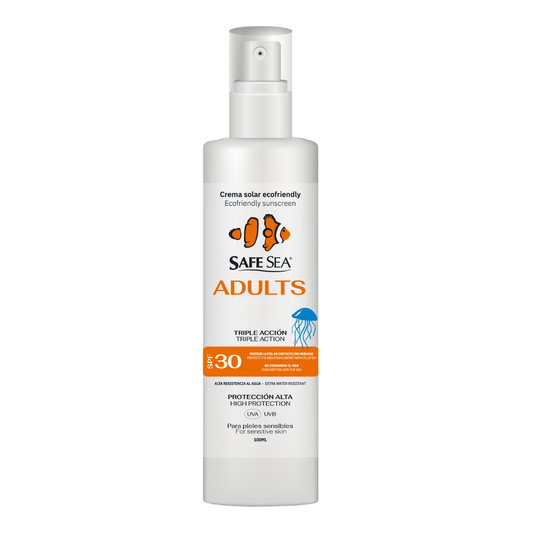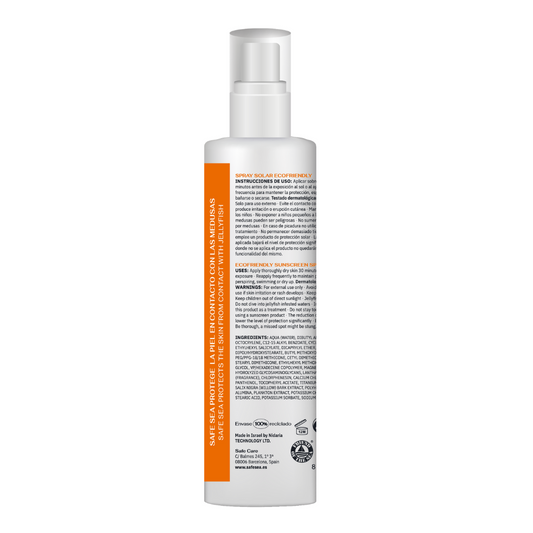- What is the Portuguese Caravel (and why is it NOT a jellyfish)?
- Map 2025 ▸ Areas with more sightings in Spain.
- Factors favoring their arrival
- Express guide for action in the event of a sting
- Frequently Asked Questions (FAQ)
- How to protect yourself before going to the beach
- Jellyfish ® anti-stinging sunscreen
Portuguese caravel: the colonial hydra that threatens Spanish summers
The plan is perfect: sun, towel, beach bar... until a lifeguard raises the purple flag. An unmistakable sign that the Portuguese caravel(Physalia physalis) has reached the coast. Its expansion already extends from Galicia and the Cantabrian Sea to the Catalan and Valencian Mediterranean.
Myth vs. Reality
| ❌ Myth | ✅ Reality |
|---|---|
| "It's a giant jellyfish." | It is a colonial hydrozoan: several organisms behaving as a single unit. |
| "In the sand she's dead." | Their tentacles are still active hours after stranding: stepping on them barefoot can hurt just as much as in the water. |
| "Only appears in the Canary Islands" | Since 2024 it has also been documented in Galicia, the Cantabrian Sea and the Mediterranean. |
Map 2025: Spanish beaches with more warnings
| Region | Provinces and hot spots | Critical period |
|---|---|---|
| North Atlantic | Galicia (A Coruña, Lugo), Asturias (Rodiles), Cantabria, Basque Country (La Concha, Gorliz) | May - September |
| Canary Islands | Gran Canaria, Tenerife north, Lanzarote | year-round, peaks in spring |
| South Atlantic | Cádiz and Huelva (after southern storms) | april - june |
| Mediterranean | Tarragona (Altafulla, Tamarit), Valencian Community, Murcia | july - august |
*Based on 2024-2025 press and Red Cross records. Check in real time the apps AEMET Playas or MeteoMed.
Pro Tip ▸ Turn on "dangerous wildlife" notifications on AEMET or MeteoMed to receive push alerts before you get to the beach.
Why are there more caravels than ever?
- Increased sea surface temperature → accelerates the reproductive cycle of jellyfish or similar organisms.
- Changes in wind patterns and currents → drift of colonies towards the coast.
- Fewer natural predators (turtles, sunfish) → population imbalance. More jellyfish on our beaches.
- Extreme weather events → storms that "push" the gas sails of the caravel towards the shore.
Express first aid guide (keep it!)
- Stay calm and leave the water without splashing.
- Do not rub the area or apply sand, alcohol or vinegar.
- Rinse with warm sea water and remove tentacle remains with tweezers.
- Apply heat 40-45 °C for 20 min (a hot water bottle works).
- If necessary, take an analgesic and apply corticosteroid ointment.
- Go to the emergency room if the pain is severe, there is fever, nausea or allergic reaction.
Useful contact ▸ Add the number of the lifeguard station and the GPS location of the beach to your cell phone before swimming.
Portuguese Caravel Frequently Asked Questions (FAQ)
How long do the symptoms of Caravela Portuguesa sting last?
They usually subside within 2-24 h. If left untreated, it may leave superficial marks for 1-2 weeks.
Does the purple flag mean the same throughout Spain?
Yes, it indicates the presence of potentially dangerous marine fauna (jellyfish, caravels, manta rays).
Can I bathe if there is only one specimen in the sand?
No. Fragmented tentacles still sting; it is recommended to close the bath until they are removed.
Vinegar or alcohol after a Medusa sting?
Neither. Both can increase the discharge of toxins in Physalia.
How to armor yourself before touching the water
| Action | Tool |
|---|---|
| Watches wind and currents | Apps AEMET Beaches, Windy |
| Wear jellyfish sting cream. | Solar Jellyfish ® SPF 50+ |
| Wear lycra t-shirt + shorts | Physical barrier against tentacles |
| Contrast local info | Civil Protection Twitter/X, signage on site |
Why protect yourself before it happens?
Because the most uncomfortable thing about a Portuguese dogfish sting is not only the pain, but also the uncertainty: not knowing what to do, not knowing how to act quickly, and the possibility of affecting children, the elderly or people with allergies.
And because protecting yourself has never been easier than it is now.
Jellyfish Sunscreen ® (2025)
Solar Jellyfish SPF 50+ combines broad spectrum filters with peptides that block the stinging discharge of Physalia and other jellyfish.
- Suitable for children > 6 months and sensitive skin.
- Water-proof 80 min.
- Tested in vitro and in vivo by ICM-CSIC.
- Eco-Friendly: no oxybenzone or octinoxate.
⚠️ ALSO PROTECTS YOU FROM THE PORTUGUESE CARAVEL.
Discover the only sunscreen in the world that also protects you against jellyfish.

